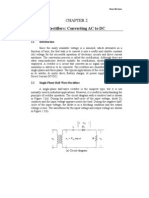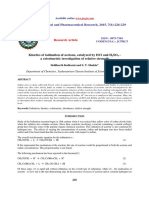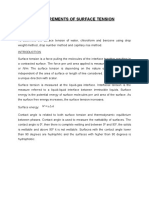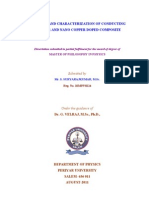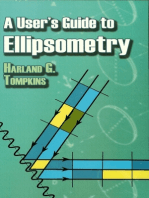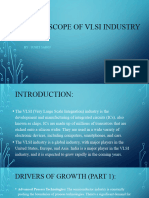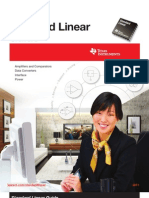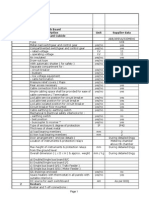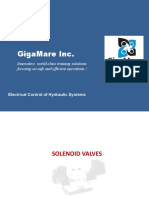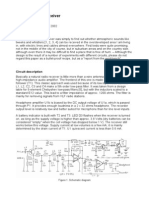Lanthanum Fluoride Laf3 Ion Selective Electrodes
Lanthanum Fluoride Laf3 Ion Selective Electrodes
Uploaded by
Gerges SamirCopyright:
Available Formats
Lanthanum Fluoride Laf3 Ion Selective Electrodes
Lanthanum Fluoride Laf3 Ion Selective Electrodes
Uploaded by
Gerges SamirOriginal Description:
Copyright
Available Formats
Share this document
Did you find this document useful?
Is this content inappropriate?
Copyright:
Available Formats
Lanthanum Fluoride Laf3 Ion Selective Electrodes
Lanthanum Fluoride Laf3 Ion Selective Electrodes
Uploaded by
Gerges SamirCopyright:
Available Formats
GUIDE TO LANTHANUM FLUORIDE
Lanthanum Fluoride crystal (LaF3) has major use as a solid membrane electrode for manufacture
into fluoride sensitive (F-1) Ion-Selective probes. Unlike other crystal materials in the Crystran range,
LaF3 is not normally used for optical applications.
CRYSTAL: LaF3 crystals are grown as nominal 10mm diameter rods. This is convenient for the ion-selective
application, as it is very difficult to grow and anneal with larger diameter than this without cracking due to
differing coefficients of expansion in the crystal orientations. The crystal can be grown pure but is generally
doped with a nominal 0.3% Europium which gives it a yellow colour and introduces more dislocations and
vacancies in the crystal lattice which aids the ionic conduction. An instance of a deliberately imperfect crystal!
The F-1 ions are relatively good conductors as they are much smaller than the La3+ ions and can move short
distances between defect vacancies in the crystal lattice. Virtually all charge transfer is due to the F-1 ions.
Lanthanum Fluoride can be doped with Nd3+ and has specialist application as a scintillating material.
ELECTRODES: Typically the LaF3 element is sealed into a rigid plastic tube with silicone rubber similar to
the assembly shown. After a settling time of several minutes, equilibrium is set up between the F-1 ions in the
surface and in the solution resulting in a charge imbalance which is dependent on the activity and concentration
of the fluoride ions under test.
The response is given by the Nernst equation:
E = Eo + slope x log10(ion concentration)
The slope is theoretically about 59/n mV at 25oC where n = -1 for F-1 ions.
Eo is a constant which incorporates the reference potentials.
Practically, for concentrations from about 1ppm the typical potential will be given
by:
E(mV) = 0.03 – 0.059 log10(ppm/100)
Typically, zero fluoride gives a potential >200mV and the slope will be 59±10mV
Typically 1ppm gives approximately 125mV and 10ppm approximately 60mV
Crystran Ltd. can only supply the shaped and polished LaF3 crystal membranes and
do not make these electrodes.
EXPERIENCE: Sometimes there can be problems in getting expected potentials and performance from LaF3
electrodes. This is not likely to be a problem in the crystal but probably in the surface polish and preparation, or
if the surface has become contaminated. It is thought the lanthanum fluoride electrode can have a surface film
resembling a hydrolyzed surface. Soaking the element in 50% glacial acetic / 50% water will generally condition
the surface for use. This is not a time critical operation, about 15 minutes should be sufficient. Wiping the LaF3
tip with a little fluoride toothpaste has been reported to work too.
REFERENCES:
Crystal Growth of Fluorides in the Lanthanide Series – D.A.Jones & W.A.Shand, J.Cryst.Growth 2 (1968) 361-368
Mechanistic Studies on Crystal-Membrane Ion-Selective Electrodes – M.J.D.Brand & G.A.Rechnitz, Anal.Chem 42 No4 April 1970
Scintillation Properties of Nd3+ doped LaF3 crystals – P.Schotanus et.al., Proc. IEEE symposium Oct. 23-17, 1989
This represents the best of our understanding at present, and is not intended to be comprehensive. Crystran Ltd cannot be responsible for any problems caused by wrongly
specified material as a result of using this data sheet. Suitability of material for purpose must always be confirmed at point of ordering.
Crystran Ltd February 2015
CRYSTRAN LTD
1, Broom Road Business Park, Poole, BH12 4PA, UK
TEL: +44 (0)1202 307650 FAX +44 (0)1202 307651
email: sales@crystran.co.uk www.crystran.co.uk
Registered in England No 2863378 VAT GB 619 6814 12
You might also like
- Small Scale Approach To Organic Laboratory Techniques 4th Edition Pavia Solutions ManualDocument4 pagesSmall Scale Approach To Organic Laboratory Techniques 4th Edition Pavia Solutions ManualmejavNo ratings yet
- Instrumental Methods For Chemical AnalysisDocument3 pagesInstrumental Methods For Chemical AnalysisGerges Samir0% (2)
- Bee4113 Chapter 2Document39 pagesBee4113 Chapter 2Kung ChinHan87% (15)
- Lab Report - IsE FluorinityDocument5 pagesLab Report - IsE FluorinityJohn LamNo ratings yet
- Determination of Fluoride Concentration Using Ion Selective ElectrodeDocument7 pagesDetermination of Fluoride Concentration Using Ion Selective ElectrodeAmanda WangNo ratings yet
- Determination of Vitamin CDocument2 pagesDetermination of Vitamin CWalwin HareNo ratings yet
- Kinetics of Iodination of Acetone Catalyzed by HCL and H2so4 A Colorimetric Investigation of Relative Strength PDFDocument4 pagesKinetics of Iodination of Acetone Catalyzed by HCL and H2so4 A Colorimetric Investigation of Relative Strength PDFHansel VereitelnNo ratings yet
- 09 - Ans To Solubility Eqm Supplemtary QN - 2012Document4 pages09 - Ans To Solubility Eqm Supplemtary QN - 2012caspersoongNo ratings yet
- Complex SaltDocument8 pagesComplex Saltmipa amarNo ratings yet
- Electrogravimetry: The Measurement of Amount of Charge Passed (Q) in Depositing The MetalDocument9 pagesElectrogravimetry: The Measurement of Amount of Charge Passed (Q) in Depositing The MetalnotmeNo ratings yet
- 11.2 Potentiometric Methods PDFDocument29 pages11.2 Potentiometric Methods PDFMohamad Abdul ChalimNo ratings yet
- Measurements of Surface TensionDocument11 pagesMeasurements of Surface TensionHema ParasuramanNo ratings yet
- 1.4.9 Waste Disposal & Micro-OrganismsDocument1 page1.4.9 Waste Disposal & Micro-OrganismsArlo RivasNo ratings yet
- An Analysis of The Themes of Freedom in One PieceDocument18 pagesAn Analysis of The Themes of Freedom in One PieceNaolNo ratings yet
- Fluoride Ion Selective ElectrodeDocument14 pagesFluoride Ion Selective ElectrodeMihEugen100% (1)
- PolypyrroleDocument106 pagesPolypyrrolesurya rajNo ratings yet
- CH425Document35 pagesCH425Vatra ReksaNo ratings yet
- Electrogravimetry 7-06Document11 pagesElectrogravimetry 7-06Bang100% (1)
- Finals PhychemDocument3 pagesFinals PhychemniezajanepatnaNo ratings yet
- Ferric OxalateDocument11 pagesFerric OxalateJoao Diniz100% (1)
- Absorbance and Fluorescence Spectroscopies of Green Fluorescent ProteinDocument24 pagesAbsorbance and Fluorescence Spectroscopies of Green Fluorescent ProteinMadel Tutor ChaturvediNo ratings yet
- Copper (Ii) AcetylacetonateDocument3 pagesCopper (Ii) Acetylacetonateken345007No ratings yet
- Simple Mixtures Colligative Properties: Chapter 7: SlideDocument32 pagesSimple Mixtures Colligative Properties: Chapter 7: SlideputriNo ratings yet
- Solubility Product ReportDocument28 pagesSolubility Product ReportYuli Astuti X TigaNo ratings yet
- Inorganic Prac 2Document3 pagesInorganic Prac 2Ray DyerNo ratings yet
- Complex SaltDocument29 pagesComplex SaltertaNo ratings yet
- ProblemsDocument20 pagesProblemsAbd El-Fattah Mohamed OufNo ratings yet
- Synthesis of TetraaminecopperDocument4 pagesSynthesis of Tetraaminecopperrahma0% (1)
- Lab Manual Metal Acetylacetonate Complexes WebDocument22 pagesLab Manual Metal Acetylacetonate Complexes WebRahul GuptaNo ratings yet
- IA Report Determination of Metals With ICP Atomic Emission SpectrometryDocument8 pagesIA Report Determination of Metals With ICP Atomic Emission SpectrometrySaranya KannanNo ratings yet
- Moving Boundary Method PDFDocument4 pagesMoving Boundary Method PDFFrancisco Novas JaimesNo ratings yet
- Electrochemical MethodDocument9 pagesElectrochemical MethodSumit VakhariaNo ratings yet
- Optical ActivityDocument4 pagesOptical ActivityJohn Mark Flores Villena100% (1)
- Lab Manual Yr 3 InorganicDocument33 pagesLab Manual Yr 3 InorganicOmSilence2651No ratings yet
- ChemistryNMRPupilWorkbookAnswersAH tcm4-723712Document18 pagesChemistryNMRPupilWorkbookAnswersAH tcm4-723712AmmarahBatool95100% (2)
- Tutorial Chapter 9-AnswersDocument7 pagesTutorial Chapter 9-AnswersNKMS:)No ratings yet
- Gravimetric AnalysisDocument20 pagesGravimetric AnalysisShally SawNo ratings yet
- Cobalt ComplexDocument11 pagesCobalt ComplexFhazzira Ajah100% (1)
- David Belias, Chem 213 Synthetic #3 FFR Experiment 9: Synthesis of A Coumarin Laser DyeDocument9 pagesDavid Belias, Chem 213 Synthetic #3 FFR Experiment 9: Synthesis of A Coumarin Laser Dyedwb530750% (2)
- Nutritional Metals in Foods by AASDocument25 pagesNutritional Metals in Foods by AASMuhammad IkbalNo ratings yet
- Field EmissionDocument6 pagesField Emissionle_fridaNo ratings yet
- Ion Selective ElectrodeDocument9 pagesIon Selective ElectrodeRekhaNo ratings yet
- Determination of Pkin of IndicatorDocument13 pagesDetermination of Pkin of IndicatorAbdullah A. Elgazar75% (8)
- The Fluoride Ion Selective Electrode ExperimentDocument5 pagesThe Fluoride Ion Selective Electrode Experimentlisaaliyo0% (1)
- Experiments 3,4,5Document13 pagesExperiments 3,4,5Athirah JamalludinNo ratings yet
- FTIR Spectrometer AnalysisDocument16 pagesFTIR Spectrometer AnalysisßraiñlĕsšȜĭnšteĭñNo ratings yet
- Chm312 AasDocument9 pagesChm312 Aassarah qistina100% (1)
- Co-Ordination and Organometallic CompDocument85 pagesCo-Ordination and Organometallic CompDr. Dhondiba Vishwanath100% (1)
- Comparison Between Spectrophotometry and Spectrofluorimetry, Its Application in Agriculture and Medicine.Document8 pagesComparison Between Spectrophotometry and Spectrofluorimetry, Its Application in Agriculture and Medicine.Ayolotu Muyiwa100% (2)
- Third Law of ThermodynamicsDocument8 pagesThird Law of ThermodynamicsJonalyn Rey100% (1)
- Determination of Specific Rotation of LactoseDocument6 pagesDetermination of Specific Rotation of LactoseMatthew VillanuevaNo ratings yet
- Ion-Selective Electrode Determination of Fluoride Ion: Chemistry 321L ManualDocument5 pagesIon-Selective Electrode Determination of Fluoride Ion: Chemistry 321L Manuallsueyin100% (1)
- Ch12 1 Transition Metals Reaction MechanismsDocument22 pagesCh12 1 Transition Metals Reaction MechanismsVirendra Singh RajputNo ratings yet
- Kgs KGS: Gujarat Alkalies and Chemicals LimitedDocument1 pageKgs KGS: Gujarat Alkalies and Chemicals LimitedChetan Solanki100% (1)
- Vibration - Rotation Spectroscopy of HCL and DCLDocument9 pagesVibration - Rotation Spectroscopy of HCL and DCLAngela LamasNo ratings yet
- The Grignard ReactionDocument3 pagesThe Grignard ReactionRoxanne Ilagan0% (1)
- Short Communication Synthesis and Applications of CoumarinDocument6 pagesShort Communication Synthesis and Applications of CoumarinSergio Rivadeneyra AntoNo ratings yet
- Reaction KineticsDocument7 pagesReaction Kineticsjathan160% (1)
- Expo Tanabe SuganeDocument8 pagesExpo Tanabe Suganesamir velezNo ratings yet
- LANTHANIDEDocument5 pagesLANTHANIDEMahesh100% (1)
- Compendium of Atomic Alkali Resistant Optical Thin Films, Diffusion and Electrical Mobility in Diode Pumped Alkali Lasers (DPALs)From EverandCompendium of Atomic Alkali Resistant Optical Thin Films, Diffusion and Electrical Mobility in Diode Pumped Alkali Lasers (DPALs)No ratings yet
- Lecture IR4Document58 pagesLecture IR4Gerges SamirNo ratings yet
- PinillaGil-Ostapczuk1993 Article DeterminationOfNickelAndCobaltDocument4 pagesPinillaGil-Ostapczuk1993 Article DeterminationOfNickelAndCobaltGerges SamirNo ratings yet
- Simple and Rapid Determination of Iodide in Table SaltDocument6 pagesSimple and Rapid Determination of Iodide in Table SaltGerges SamirNo ratings yet
- Determination of Tin in Canned Fruit JuicesDocument4 pagesDetermination of Tin in Canned Fruit JuicesGerges SamirNo ratings yet
- Chapter 16Document13 pagesChapter 16Gopal PenjarlaNo ratings yet
- N - AAS: 3.1 Limitations of Flame AASDocument12 pagesN - AAS: 3.1 Limitations of Flame AASGerges SamirNo ratings yet
- Solution:: Chapter 11 - Properties of SolutionsDocument10 pagesSolution:: Chapter 11 - Properties of SolutionsGerges SamirNo ratings yet
- AASDocument4 pagesAASGerges SamirNo ratings yet
- RSEARCH 12 2nd Sem-ADocument29 pagesRSEARCH 12 2nd Sem-AAlyssum MarieNo ratings yet
- Future Scope of VLSI IndustryDocument10 pagesFuture Scope of VLSI IndustrySumit SarojNo ratings yet
- Live Wire TutorialDocument6 pagesLive Wire TutorialMagfur RamdhaniNo ratings yet
- Class D Amplifier With Maximum Power Adjustable From 20W To 300WDocument13 pagesClass D Amplifier With Maximum Power Adjustable From 20W To 300Wramontv032428100% (1)
- Pill CameraDocument18 pagesPill CameraMounika GabbetaNo ratings yet
- AF-6 Catalogue Ed02 (En)Document64 pagesAF-6 Catalogue Ed02 (En)NateshNo ratings yet
- Vishay Semiconductors: FeaturesDocument8 pagesVishay Semiconductors: FeaturesLeo GuillermoNo ratings yet
- SCT2932V01 01Document25 pagesSCT2932V01 01Iliescu CatalinNo ratings yet
- Experiment No. 04Document11 pagesExperiment No. 04Kris Dominic RubillosNo ratings yet
- Erno Borbely Servo 100 From Audio-Amateur-1984-1Document64 pagesErno Borbely Servo 100 From Audio-Amateur-1984-1ehsannemesis6No ratings yet
- TheftDocument12 pagesTheftEmeka Nelson OffornedoNo ratings yet
- SLVT 145 JDocument105 pagesSLVT 145 JthắngNo ratings yet
- Heathkit IT-12 Manual 1962Document30 pagesHeathkit IT-12 Manual 1962putchi56No ratings yet
- DS0026 Dual High-Speed MOS Driver: General Description FeaturesDocument8 pagesDS0026 Dual High-Speed MOS Driver: General Description FeatureslujorebNo ratings yet
- TK12A60U: Switching Regulator ApplicationsDocument6 pagesTK12A60U: Switching Regulator ApplicationsPiter De AzizNo ratings yet
- General General General General Description Description Description DescriptionDocument8 pagesGeneral General General General Description Description Description DescriptionkksandeepNo ratings yet
- 11 KV MV Board.Document10 pages11 KV MV Board.costea0028No ratings yet
- Industrial Controls - Sirius Relays PDFDocument50 pagesIndustrial Controls - Sirius Relays PDFChioibasNicolaeNo ratings yet
- Handout13 PDFDocument16 pagesHandout13 PDFShamithaNo ratings yet
- Gujarat Technological UniversityDocument2 pagesGujarat Technological Universitymec091ownerNo ratings yet
- Advanced Technologies For Next Generation Integrated CircuitsDocument321 pagesAdvanced Technologies For Next Generation Integrated CircuitsIEC2020034No ratings yet
- Basic Analog CircuitsDocument35 pagesBasic Analog CircuitsWaleedWaelNo ratings yet
- Data Sheet ET Solar 295WDocument2 pagesData Sheet ET Solar 295WLi RusNo ratings yet
- Unisonic Technologies Co., LTD: Middling Voltage Fast-Switching NPN Power TransistorDocument3 pagesUnisonic Technologies Co., LTD: Middling Voltage Fast-Switching NPN Power TransistorAnabell RodriguezNo ratings yet
- Module 10 - 5 Electrical Control of Hydraulic SystemsDocument41 pagesModule 10 - 5 Electrical Control of Hydraulic SystemsJaphet GabatanNo ratings yet
- Smart Textile in Fashion IndustryDocument10 pagesSmart Textile in Fashion IndustrySaurav kumarNo ratings yet
- Electric Power CablesDocument6 pagesElectric Power CablesVENKATESAN RNo ratings yet
- Design Rule Check: By:-Chandan ROLL NO. 15/914 B.SC (Hons.) ELECTRONICS ScienceDocument9 pagesDesign Rule Check: By:-Chandan ROLL NO. 15/914 B.SC (Hons.) ELECTRONICS ScienceChandan KumarNo ratings yet
- Natural Radio ReceiverDocument4 pagesNatural Radio ReceiverFJ GLNo ratings yet


